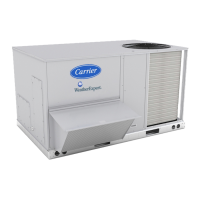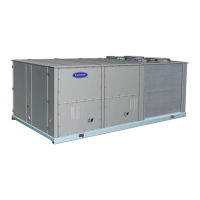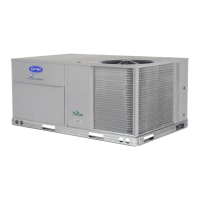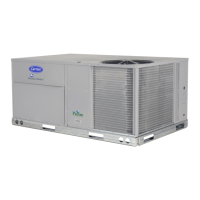76
before trusting the SAT reading, and has been reused for Title
24 purposes.
Economizer Deadband Temp
(AC.EC) — The allowed
deadband between measured SAT and calculated SAT when
performing economizer self-test. Range is 0-10, default is 4.
Econ Fault Detect Gap
(E.GAP) — The discrepancy be-
tween actuator command and reported position in %. Used to
detect actuator stuck/jammed. Range is 2-100, default is 5.
Econ Fault Detect Timer
(E.TMR) — The timer for actuator
fault detection in seconds. Used to detect actuator stuck/
jammed. Range is 10-240, default is 20.
Excess Air CFM
(X.CFM) — The max allowed excess air in
CFM. Used to detect excess outside air. Range is 400-4000, de-
fault is 800.
Excess Air Detect Timer
(X.TMR) — The timer for excess
air detection with a range of 30-240. Default is 150.
Econ Auto-Test Day (
EC.DY) — The day on which to per-
form automatic economizer test. Range=NEVER, MON, TUE,
WED, THR, FRI, SAT, SUN. Default is SAT.
Econ Auto=Test Time (
EC.TM) — The time at which to per-
form automatic economizer test. The range is 0-23, default is 2.
T24 AutoTest SF Run Time
(AC.MR) — Amount of time to
run supply fan before sampling torque or making torque com-
parison. Range is 1 to 10, default is 2.
T24 Auto-Test VFD Speed
(AC.SP) — Speed to run VFD
during economizer auto-component test. Range is 10 to 50, de-
fault is 20.
T24 Auto-Test Econ % Open (
AC.OP) — Amount to open
each economizer during auto-component test. Range is 1 to
100. Default is 30.
T24 Auto-Test VFD % Change
(VF.PC) — Expected
change in torque when damper opens from 0 to AC.OP and
then from AC.OP to 0. Range is 1 to 20, default is 10.
SETTING UP THE SYSTEM — The economizer configura-
tion options are under the Local Display Mode Configura-
tion
ECON. See Table 54.
ECONOMIZER OPERATION
Is Economizer Enabled?
— If an economizer is not being
used or is to be completely disabled the configuration option
EC.EN may be set to NO. Otherwise the economizer enabled
configuration must be set to YES. Without the economizer en-
abled, the outdoor-air dampers will open to minimum position
when the supply fan is running. Outdoor-air dampers will
spring-return closed upon loss of power or shutdown of the
supply fan.
What is the Economizer Minimum Position?
— The config-
uration option EC.MN is the economizer minimum position.
See the section on Indoor Air Quality for further information
on how to reset the economizer even further to gain energy sav-
ings and to more carefully monitor "indoor IAQ problems."
What is the Economizer Maximum Position?
— The upper
limit of the economizer may be clamped if so desired via con-
figuration option EC.MX.
It defaults to 98% to avoid problems associated with slight
changes in the economizer damper's end stop over time. Typi-
cally this will not need to be adjusted.
What is Economizer Trim for Sum Z?
— A strange title but a
simple explanation. Sum Z stands for the adaptive cooling
control algorithm used for multiple stages of compression. The
configuration option, E.TRM is typically set to Yes, and allows
the economizer to modulate to the same control point "Sum Z"
uses to control compressor staging. The advantage is lower
compressor cycling coupled with tighter temperature control.
Setting this option to "No" will cause the economizer, if it is in-
deed able to provide free cooling, to open to the Economizer
Max. Position (EC.MX) during mechanical cooling.
ECONOMIZER CHANGEOVER SELECTION — There
are four potential elements at play which may run concurrently
which determine whether the economizer is able to provide
free cooling:
• Dry Bulb Changeover (outside air temperature qualifica-
tion)
• The Enthalpy Switch (discrete switch input monitoring)
• Economizer Changeover Select (E.SEL economizer
changeover select configuration option)
• Outdoor Dewpoint Limit Check (needs an outdoor rela-
tive humidity sensor installed)
Dry Bulb Changeover
— Outside-air temperature may be
viewed under Temperatures
AIR.T
OAT.
The control constantly compares its outside-air temperature
reading against OAT.L. If the temperature reads above OAT.L,
the economizer will not be allowed to perform free cooling.
NOTE: If the user wishes to disable the enthalpy switch from
running concurrently, a field-supplied jumper must be installed
between TB201 terminals 3 and 4.
Enthalpy Switch
— The state of the enthalpy switch can be
viewed under Inputs
GEN.I
ENTH. Enthalpy switches are
installed as standard on all N Series rooftops. When the switch
reads HIGH, free cooling will be disallowed.
The enthalpy switch opens* when the outdoor enthalpy is
above 24 Btu/lb or dry bulb temperature is above 70 F and will
close when the outdoor enthalpy is below 23 Btu/lb or the dry
bulb temperature is below 69.5 F.
There are two jumpers under the cover of the enthalpy
switch. One jumper determines the mode of the enthalpy
switch/receiver. The other is not used. For the enthalpy switch,
the factory setting is M1 and should not need to be changed.
The enthalpy switch may also be field converted to a differ-
ential enthalpy switch by field installing an enthalpy sensor
(33CSENTSEN or HL39ZZ003). The enthalpy switch/receiver
remains installed in its factory location to sense outdoor air en-
thalpy. The additional enthalpy sensor is mounted in the return
air stream to measure return air enthalpy. The enthalpy control
jumper must be changed from M1 to M2 for differential enthal-
py control. For the return air enthalpy sensor, a "two wire" sen-
sor, connect power to the Vin input and signal to the 4-20 loop
input.
It should be noted that there is another way to accomplish
differential enthalpy control when both an outdoor and return
air relative humidity sensor are present. See section on Econo-
mizer Changeover Select for further information.
*NOTE: The enthalpy switch has both a low and a high output.
To use this switch as designed the control must be connected to
the "low" output. Additionally there is a "switch logic" setting
for the enthalpy switch under Configuration
IAQ
SW.LG
ENT.L. This setting must be configured to closed
(CLSE) to work properly when connected to the low output of
the enthalpy switch.

